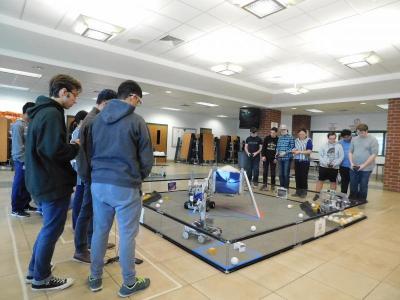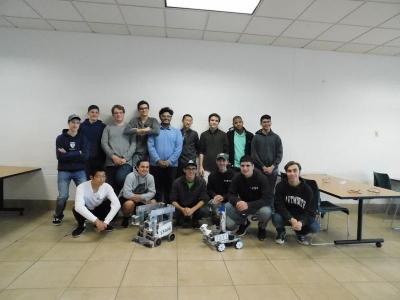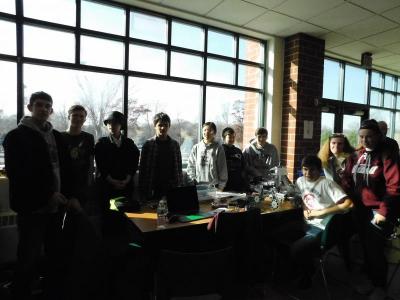Robotics teams compete and collaborate at Dartmouth High School
Even though the school was closed, the cafeteria at Dartmouth High School was buzzing on Monday as dozens of young engineers worked on robots.
Eight robotics teams from high schools across the state gathered to work together and practice completing this year’s "First Tech Challenge."
Nick Carnes, a co-captain of Dartmouth’s 7571 Alumineers team, explained that this year’s challenge has several parts. The robots must perform some tasks autonomously without being driven by students, and then be driven to complete other tasks. The robots must pick up two different kinds of “minerals” (yellow cubes and white balls), place them in the appropriate containers, and finish by raising itself off the ground while hanging from a center structure.
The Alumineers have already figured out how to lift the robot off the ground, which they are excited about because it will earn them 50 points at competition.
“It’s the hardest [task] — what we call end game,” Carnes said.
Engineering teacher Sam Brodsky emphasized the teamwork that is inherent in the program.
“It’s a really great program, a really authentic engineering experience,” Brodsky said. “There is no way you could do this solo.”
The spirit of collaboration isn’t limited to the individual teams.
“We help other teams out by, our coder will give other teams coding advice, and if they don’t have a part, we’ll give it to them,” Carnes said. “You want your opponents to be at their best game.”
For co-captain Nick McMaster, a highlight of the event was getting to see how other teams were approaching the challenge.
“Engineering is basically an art because you can give 100 kids the same problem and get 100 different solutions,” McMaster said. “It’s really interesting to see how different minds work.”
Dartmouth’s other robotics team, 13406 or The Plastigears, was formed last year due to the overwhelming interest from students.
Vaibhav Dubey, the president of the whole robotics club, said that the Plastigears are working through the challenge chronologically and starting with the minerals portion, in contrast to the Alumineers, which is prioritizing tasks by point value.
“We planned every single gear and screw on paper, then started building,” Dubey said.
The team uses many low-cost and recycled materials like cardboard, duct tape, rubber bands, and string, which also reduce the robot’s weight. After a few scrimmages, Dubey said the team’s focus is on improving the robot’s efficiency.
“It’s working, but not too well,” Dubey said. “Sometimes it tumbles over.”
Kathy Leong, a parent of one of the teammates, said she loves watching the team’s progress over the season.
“Seeing their robot from scratch to working stage is really really cool,” Leong said.
The teams work hard, spending an hour and a half after school twice a week and up to nine hours on weekends building, programming, and testing their robots.
Bishop Stang’s robotics team was also at the scrimmage, and was proud of their progress — especially because the team didn’t exist until two years ago.
“The season’s going very well, and we’re making a lot of progress each meet,” said Michael Mello.
KJ Gallison and Christine Yu, the team’s co-captains, said one of their focuses this year is maintaining an engineering notebook which records their work and is required at competitions. The team wants their robot to be able to move not only forwards and backwards but to the left and right, so they are using a special set of wheels. Part of their focus on Monday was making sure all the parts of the robot were secure, so wheels wouldn’t fall off during a match.
















